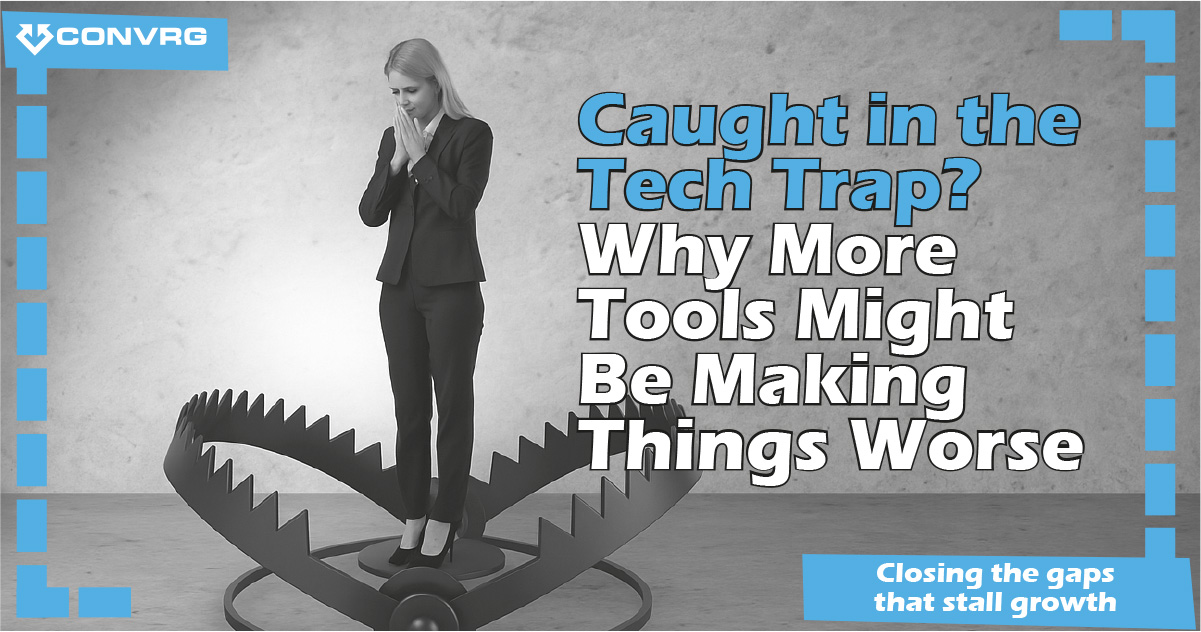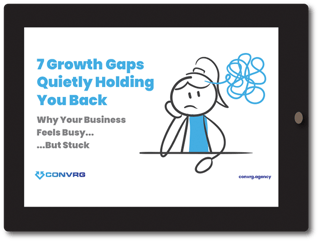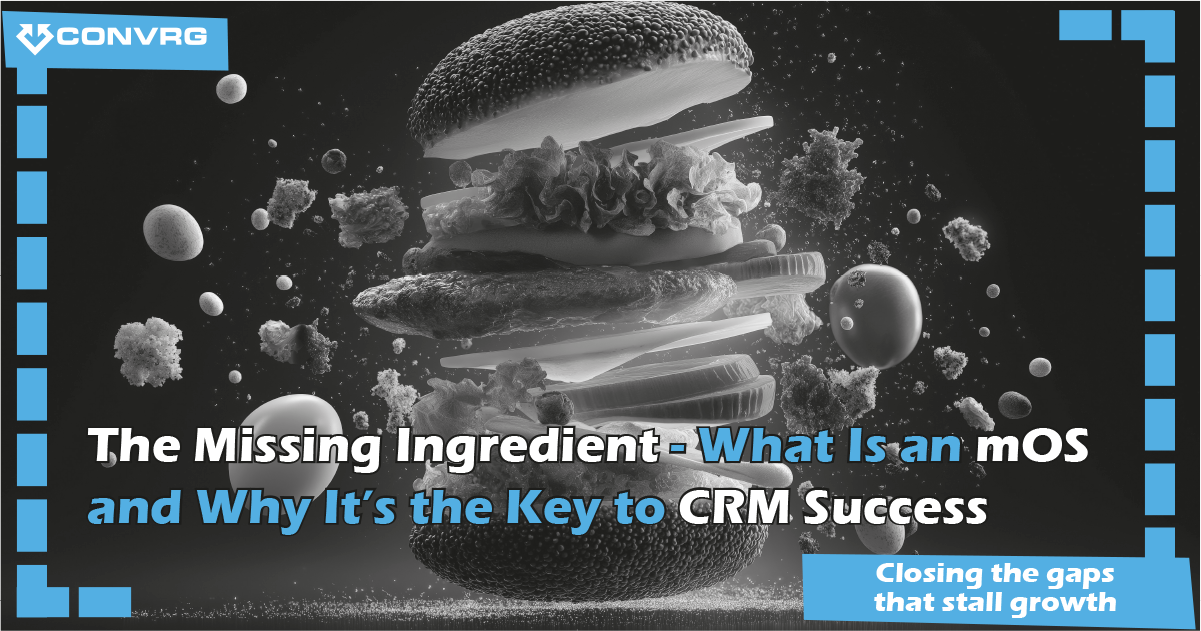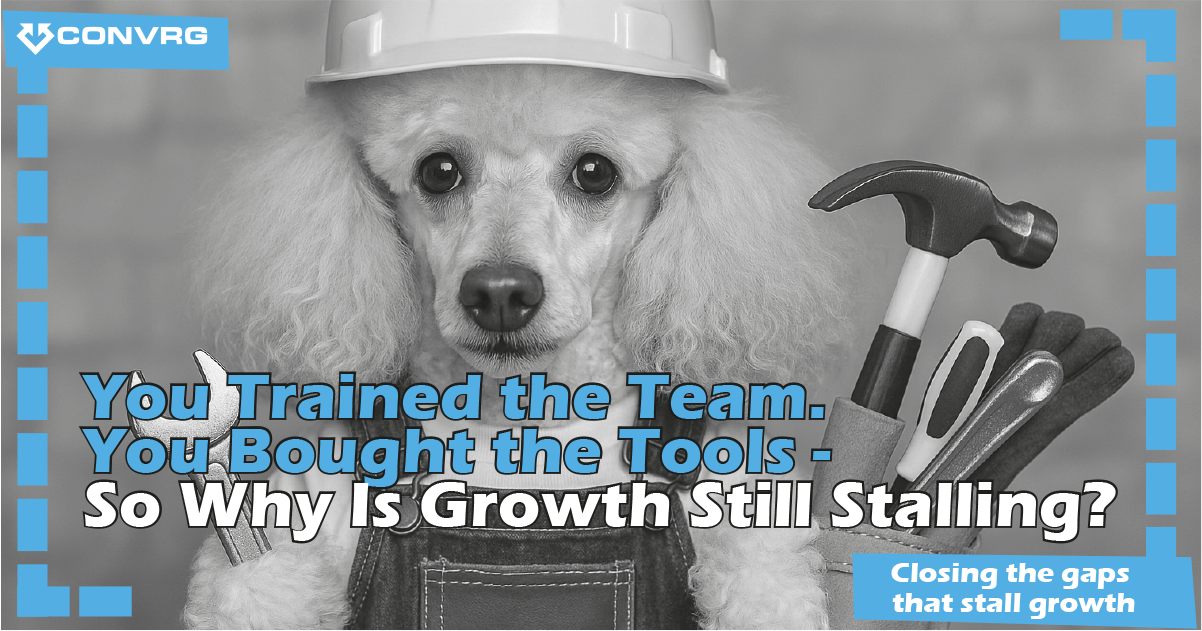The Tech Trap Isn’t a Gap. It’s a Symptom.
You’ve invested in your stack.
CRM?
Marketing automation?
Dashboards, project tools, comms platforms?
You didn’t cut corners.
You bought the good stuff.
So why does your team still feel stuck?
Why are deals slipping through the cracks?
Why is data conflicting between systems?
Why are simple projects getting lost in a sea of Slack threads and siloed reports?
Welcome to what we call the Tech Trap.
It’s not one of the Growth Gaps themselves - but it’s often what happens when several of them collide.
Think of it as the smoke signal. The visible frustration.
But the fire is deeper.
The Tech Trap is usually a byproduct of three major underlying issues:
- A Leadership Gap - where vision isn’t aligned across teams
- A Systems Gap - where tools exist, but aren’t connected
- A Data Gap - where no one trusts what’s in front of them
More platforms won’t fix these gaps. In fact, they usually make them worse.
The Irony of the Modern Tech Stack
The promise was simple:
Buy the right tools and everything becomes easier.
- Tasks get automated
- Reporting becomes real-time
- Teams collaborate better
- Growth gets faster
But for many scale-ups, the reality is very different.
Instead of flow, you get friction.
Instead of clarity, you get chaos.
And the more tools you add, the worse it gets.
Here’s the irony:
You bought tools to save time - but you’re spending more of it trying to make them work.
When Tools Multiply - But Systems Don’t
Let’s break it down.
The average B2B mid-market company now uses over 100 different SaaS apps across departments.
Each was chosen for a reason. Each promised a fix.
But without a unifying system behind them, those tools just become another layer of complexity.
You’ve probably heard (or said) things like:
“Which version of the truth are we using for this?”
“That’s in Asana. No, wait... it’s in Trello.”
“We’ve automated that workflow... but no one’s sure what it triggers.”
“We’re using the CRM, but only for pipeline reporting.”
“We built that in HubSpot - but no one updated it after launch.”
This isn’t a tooling problem.
It’s a systems problem disguised as a software decision.
How the Tech Trap Slows You Down
You know you’re caught in the Tech Trap when:
- No one trusts the data
Teams pull different numbers from different tools - and argue over whose dashboard is right. - Processes are inconsistent
Sales and marketing work from different playbooks. Ops is left to clean up the handover mess. - Automation becomes spaghetti
Tools fire off sequences, alerts, and updates - but no one’s sure what triggers what, or when. - CRM adoption suffers
Not because people don’t care, but because the system doesn’t reflect how the business actually works. - Leadership is stuck in reaction mode
Chasing numbers. Chasing updates. Chasing people - instead of leading the strategy.
It’s death by a thousand disconnected workflows.
And the more tools you bolt on, the further you drift from the operational clarity your business actually needs.
Tech Alone Can’t Save a Broken System
Just because something’s digital doesn’t mean it’s working.
Automating a broken process doesn’t fix the problem - it just spreads the chaos faster.
At CONVRG, we’ve seen this again and again.
Smart, scaling teams who’ve spent thousands on great tools - but are still:
- Stuck in silos
- Duplicating effort
- Drowning in dashboards
- Frustrated with their CRM
- And wondering why growth feels harder, not easier
It’s not a lack of investment.
It’s a lack of integration, alignment, and clarity.
And no new platform is going to fix that.
It’s Not About the Tools - It’s About the Operating Model
Here’s the hard truth:
A tech stack is only as good as the system it supports.
And in too many businesses, the system doesn’t exist.
There’s no shared way of working.
No agreed process for how leads move.
No central owner for data cleanliness.
No leadership rhythm for decision-making.
So the tools end up compensating for the system that’s missing.
And instead of unlocking growth - they just highlight the gaps.
That’s the Tech Trap:
Believing that more tools = more progress
When really, more tools without structure = more mess.
A Real Example: How Frontier Escaped the Tech Trap
Let’s take Frontier Medical Group – a global manufacturer in the healthcare sector.
They weren’t tech-averse. Far from it.
They’d implemented HubSpot. Built a capable team. Set ambitious growth targets.
But things weren’t clicking.
- Sales and telesales operated in silos
- Leads were tracked in notepads, spreadsheets, and memory
- Field reps had little visibility into what marketing was doing
- The CRM wasn’t trusted - and certainly not central
- Leadership couldn’t forecast accurately or see what was really happening in the pipeline
In short? The tools were there. But the system wasn’t.
That’s where we stepped in.
Using the SIMPLIFI Framework, we helped them stop treating HubSpot like “just another platform” - and start using it as the operating model for scale.
We worked from the inside out:
- Aligned leadership with a bold growth vision
- Interviewed every commercial function to uncover blockers and gaps
- Mapped how teams really worked and rebuilt the CRM around them
- Created a CRM Management Control System tailored to field sales, telesales, and territory logic
- Cleaned decades of messy data and restructured reporting
- Rolled out custom playbooks, workflows, and mobile-friendly tools
- Embedded training, change champions, and leadership rhythms to keep it alive
The result?
- 94% increase in qualified leads
- 483% rise in attributable revenue
- Forecasting accuracy and full visibility across the commercial engine
- A trusted, centralised CRM that’s used daily - not bypassed
They didn’t need more software.
They needed a system that made their stack actually work.
The 7 Growth Gaps Behind the Tech Trap
Through hundreds of engagements, we’ve identified the most common reasons scale-ups stall - and how tool overload makes them worse.
Here are the 7 Growth Gaps:
- The Sales Gap
You’re generating leads - but they’re not turning into deals.
Manual follow-ups, ad hoc forecasting, and inconsistent qualification hold you back.
- The Marketing Gap
Campaigns are running - but no one knows what’s working.
Handoffs are weak. Funnels don’t convert. Content sits unused.
- The Data Gap
Dashboards exist - but they don’t match.
Dirty data, disconnected systems, and multiple “truths” block decisions.
- The Leadership Gap
Strategy lives in slides - not day-to-day operations.
Teams aren’t aligned. Priorities shift. Energy gets scattered.
- The Customer Gap
Product is great - but the experience is patchy.
Onboarding breaks down. Support feels disconnected. Feedback gets lost.
- The Execution Gap
Everyone’s working hard - but not together.
Actions don’t stick. Processes aren’t followed. Momentum fades.
- The AI Gap
You’re feeling pressure to “do something with AI” - but there’s no strategy.
Experiments are disconnected. Automation creates confusion. Teams feel excluded.
Adding more tools doesn’t close these gaps.
In fact, it often widens them.
Ask a Better Question: What Are You Actually Trying to Fix?
Before you buy another platform, ask:
- What’s really not working here?
- Do we have a process problem, a people problem, or a platform problem?
- What would success look like 6 months from now?
- Who owns it? And do they have what they need?
Because if you’re adding more tech to a broken system - you’re not solving the problem.
You’re just burying it deeper.
Stop Adding Tools. Start Fixing the Gaps.
If your tech stack feels bloated, confusing, or misaligned - the issue isn’t your software.
It’s the system around it.
Before you invest in anything new, download our 7 Growth Gaps Guide.
It will help you:
- Diagnose the real blockers inside your business
- See where your current tools might be hurting more than helping
- Prioritise what to fix first - without wasting more time or money
[Download the 7 Growth Gaps Quietly Holding You Back]
It’s not about buying more tech.
It’s about building a business that can scale with what you’ve already got.








